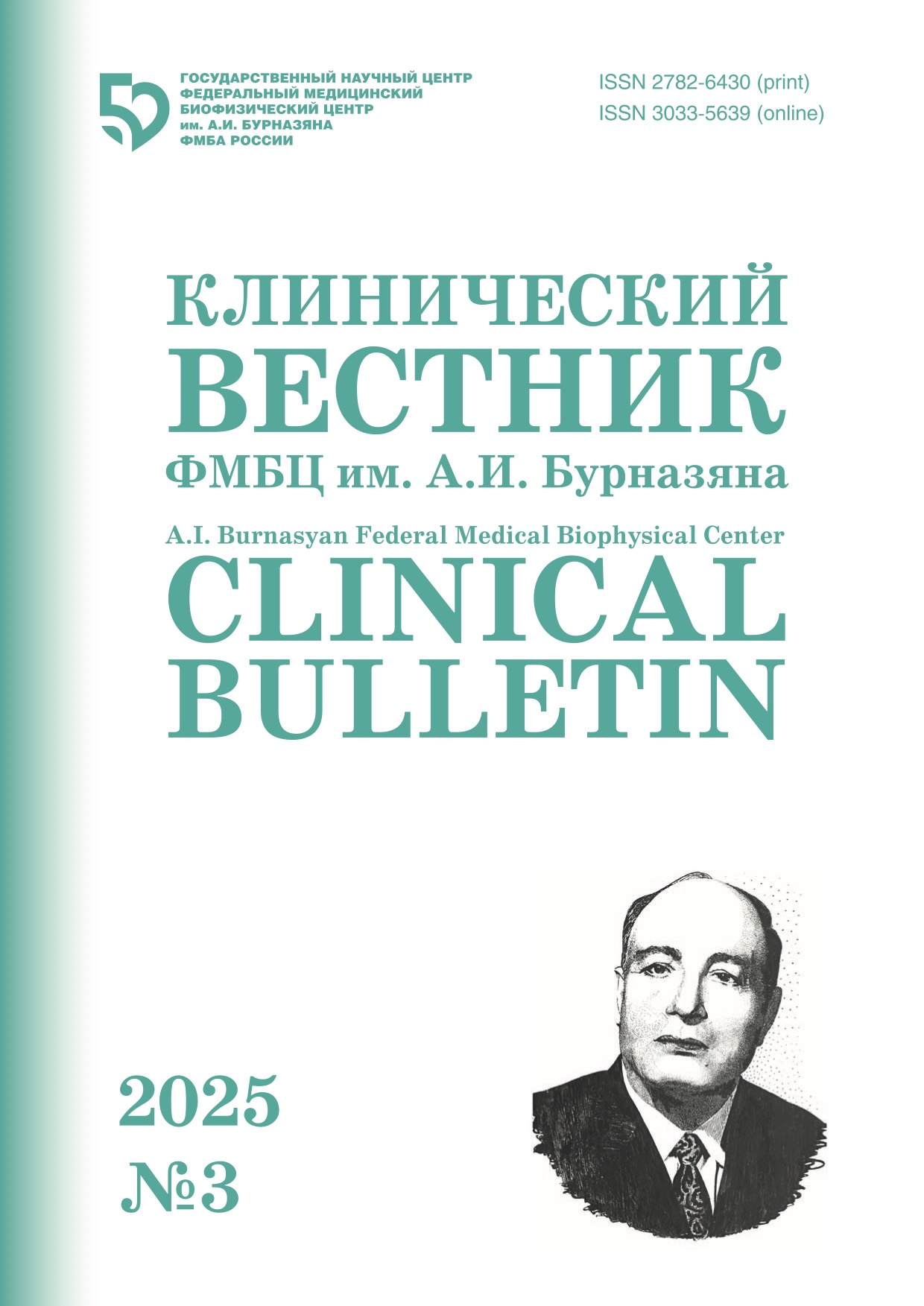A.I. Burnasyan FMBC clinical bulletin. 2025 № 3
P.S. Kyzlasov, A.I. Bokov, A. E. Kuklenko, A. G. Korchagin, K.A. Eroshkina, O. V. Parinov,
S.E. Voskanyan, K. A. Popugaev
Acute Obstructive Pyelonephritis as a Trigger of Atypical Hemolytic Uremic Syndrome (Clinical Case)
International Office, State Research Center – Burnasyan Federal Medical Biophysical Center
of Federal Medical Biological Agency, Moscow, Russiа
Contact person: BokovAlexey Ivanovich: dr.Bokov@bk.ru
Abstract
Atypical hemolytic-uremic syndrome (aHUS) is a systemic disease from the group of thrombotic microangiopathies (TMA) with a progressive course and an unfavorable prognosis, which is based on uncontrolled activation of an alternative complement pathway (APC) of a hereditary or acquired nature, leading to generalized thrombosis in the vessels of the microcirculatory bed.
Acute obstructive pyelonephritis (OOP) is an infectious kidney disease that can be complicated by urinary tract obstruction. The relationship between aHUS and OOP remains poorly understood, which makes this clinical case particularly important to study. A clinical case of atypical hemolytic-uremic syndrome developed against the background of acute obstructive pyelonephritis is presented. The analysis of which will reveal the possible pathophysiological mechanisms underlying this rare combination.
The urological department of the Center of Urology and Andrology of the Burnazyan State Clinical Medical Center was attended by a 34-year-old patient R. with a clinical picture of a concretion of the left ureter and acute obstructive pyelonephritis. Confirmed by laboratory and instrumental examination data. In order to restore the passage of urine, the upper urinary tract is drained by a ureteral stent. In the hours following urinary tract drainage, the patient complained of severe lower back pain, severe general weakness, numbness in the lower extremities, and chills. Upon examination by the doctor on duty, there is an increase in intoxication, pronounced phenomena of microcirculation disorders, cyanosis of the nose, upper and lower extremities, hypotension, decreased saturation. The condition was assessed as an infectious and toxic shock, and the patient was transferred to the Department of Anesthesiology and Intensive Care Unit No. 1 for intensive therapy. During further examination and treatment, the patient showed signs of hemolytic anemia, thrombocytopenia, and acute renal failure, which led to the suspicion of aHUS.
The patient showed clinical and laboratory signs of aHUS, including a decrease in hemoglobin to 76 g/l, erythrocytes to 2.67×10-12/l, leukocytes to 41.1×109/l, platelets to 6×109/l and an increase in creatinine to 513 mmol/L. A genetic study conducted at a specialized nephrology department revealed a mutation in the CFH gene, which confirmed the diagnosis of aHUS.
Treatment at the Burnazyan Scientific Research Center included: antibiotic therapy, glucocorticosteroids, anticoagulant, hemotransfusion, infusion, vasopressor, gastroprotection, antisecretory, metabolic, rheological therapy. Effective detoxification techniques: prolonged venous hemodiafiltration (CVVHDF), LPS sorption (lipopolysaccharide sorption of gram-negative bacterial endotoxins), high-volume plasma exchange, as well as therapy recommended by specialized specialists. 18 days after the start of treatment, an improvement in vital functions was noted, which allowed the patient to be transferred to a specialized nephrological hospital. The results of this clinical case confirm the possibility of developing atypical hemolytic-uremic syndrome against the background of acute obstructive pyelonephritis as a trigger. This clinical case demonstrates the importance of timely diagnosis and treatment of aHUS, especially in patients with infectious kidney diseases. Further research is needed to elucidate the pathophysiological mechanisms underlying this rare combination and develop optimal treatment strategies.
Keywords: acute pyelonephritis, urolithiasis, infectious and toxic shock, thrombotic microangiopathy (ТМА), hemolytic-uremic syndromeм
For citation: Kyzlasov PS, Bokov AI, Kuklenko A E, Korchagin AG, Eroshkina KA, Parinov OV, Voskanyan SE, Popugaev KA. Acute Obstructive Pyelonephritis as a Trigger of Atypical Hemolytic Uremic Syndrome (Clinical Case) s. A.I. Burnasyan Federal Medical Biophysical Center Clinical Bulletin. 2025.3:67-74. (In Russian) DOI: 10.33266/2782-6430-2025-3-67-74
REFERENCES
- Иванова О.В., Петрова А.С. Современные подходы к диагностике и лечению атипичного гемолитико-уремического синдрома // Российский медицинский журнал. 2018. Т.24. №3. С. 123-130 [Ivanova O.V., Petrova A.S. Modern Approaches to Diagnostics and Treatment of Atypical Hemolytic Uremic Syndrome. Rossiyskiy Meditsinskiy Zhurnal = Russian Medical Journal. 2018;24;3:123-130 (In Russ.)].
- Сидоров М.А., Кузнецов И.В. Острый обструктивный пиелонефрит: клинические особенности и тактика лечения // Урология. 2019. Т.4. №2. С. 89-95 [Sidorov M.A., Kuznetsov I.V. Acute Obstructive Pyelonephritis: Clinical Features and Treatment Tactics. Urologiya = Urology. 2019;4;2:89-95 (In Russ.)].
- Noris M., Remuzzi G. Atypical Hemolytic Uremic Syndrome. J Am Soc Nephrol. 2009;20;9:1799-1807. doi:10.1681/ASN.2008080844.
- Talan D.A., Stamm W.E. Urinary Tract Infections in Adults. In: Mandell, Douglas, and Bennett’s Principles and Practice of Infectious Diseases. 7th ed. Philadelphia, Churchill Livingstone, 2010.
- Caprioli J., Noris M., Brioschi S., et al. Genetics of HUS: the Impact of MCP, CFH, and IF Mutations on Clinical Presentation, Response to Treatment, and Outcome. Blood. 2006;108;4:1267-1279. doi:10.1182/blood-2006-02-004168.
- Sellier-Leclerc A.L., Fremeaux-Bacchi V., Dragon-Durey M.A., et al. Differential Impact of Complement Mutations on Clinical Characteristics in Atypical Hemolytic Uremic Syndrome. J Am Soc Nephrol. 2007;18;8:2392-2400. doi:10.1681/ASN.2007020204.
- Hillmen P., Young N.S., et al. The Complement Inhibitor Eculizumab in Paroxysmal Nocturnal
Conflict of interest. The authors declare no conflict of interest.
Financing. The study had no sponsorship.
Contribution. Article was prepared with equal participation of the authors.
Article received: 18.05.2025. Accepted for publication: 05.06.2025


